The Indian Space and Research Organisation (ISRO), India’s national space agency, will launch its first space-based mission to study our parent star on 2nd September 2023 from the Sathish Dhawan Space Centre in Sriharikota. The launch of the Aditya-L1 mission took place over a week after the soft lunar landing of Chnadrayaan-3.
The Aditya-L1 mission is also known as the Aditya – Lagrange 1. The mission’s name gives a succinct description of its focus and its observational position. In Sanskrit, Aditya means Sun and Lagrange 1 is a mathematical point between the Earth and the Sun. Aditya-L1 will study the Sun from the Lagrange 1 position.
Conceptualized as Aditya-1 in January 2008, Aditya-1 was to be 400 kg with one payload and observe our Sun in LEO. The mission objectives have expanded since its conceptualization. Thus, the satellite is now a solar and space environment observatory and will be positioned at the L1 point. Consequentially, the mission was renamed Aditya-L1. The Aditya-L1 satellite is 1500 kg with seven special instruments called payloads onboard. These payloads will provide crucial information that could help us understand solar weather and the solar magnetic field.
The XL variant of ISRO’s Polar Satellite Launch Vehicle (PSLV) will launch the satellite. This launch is the 59th launch of the PSLV class and the 57th commercial launch. Aditya-L1, like the Chandrayaan spacecraft, will initially be placed in the Low Earth Orbit (LEO), before being propelled towards the L1 point, a journey that approximately takes four months.

Events and Celebrations by Space India
On 2nd September 2023, Space-India organized a Solar Observation event at Sector-39, Noida Society. This event was to celebrate ISRO’s Aditya-L1 mission and to impart the mission’s significance at ground level at Noida’s 39 Sector societies in the presence of FONRWA, Shri Yogendra Sharma. Several activities, such as hydro-rocketry, quiz, comet making, etc, were conducted at this event and more than 300 people participated. The event imparted scientific temperament and society members were motivated to do such events on regular basis!

Likewise, at various Space Empowered Schools, such as Delhi Public School (DPS) Faridabad, Bal Bharati School, Pitampura, etc. hosted a Solar observation and Aditya L1 drawing/painting session.
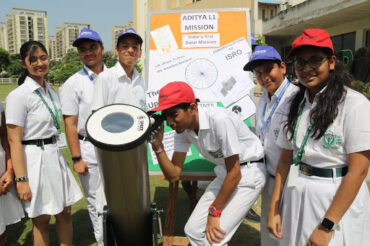
Simultaneously, Space-India’s Chennai team was at the launch site, Sriharikota. The Space team enjoyed the launch with the thousands of people present at the site. The excursion was memorialized by the spectacular photographs the team captured as PSLV-C57/Aditya-L1 shot into the clear morning sky.
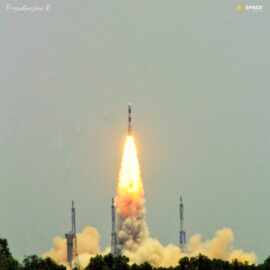
Furthermore, at Spaceship, Dwarka (Space HQ office), a “chai pe charcha” session became an enthralling discussion. Spacians got to explore the science behind the Aditya L1 mission as expert space science educators explained the momentous Aditya L1 Mission dynamics to Spacians, while the team enjoyed Chai (Indian Tea), Spacians enjoyed a live screening of the launch. The event also saw an invigorating talk by MD, Space India, Mr. Shivam Gupta, who took a moment to inspire Space Educators to passionately teach science education at schools and move forward in contributing towards making India the greatest country in the world.
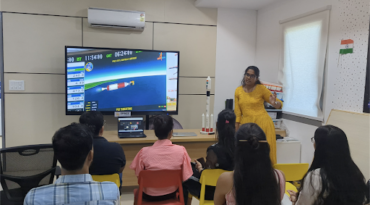
Finally, our experts appeared on various Hindi and English news channels, in person and online, helping the general public understand the need to study our star while clarifying the expected path the Aditya L1 spacecraft will take towards its destination; it was truly a magical and proud moment for Space India following the massive success of Chandrayaan 3 by ISRO.
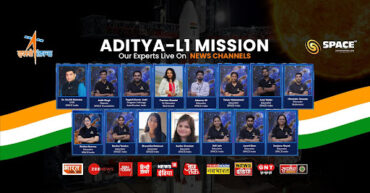
Aim of Aditya-L1
The primary goal of Aditya-L1 is to study the solar atmosphere (an extremely hot and dynamic region,) and the solar magnetic field. The major objectives of the mission in detail are:
- • To study the dynamics of the chromosphere and corona.
- • To understand the physics of the partially ionized plasma, initiation of coronal mass ejection (CME) and flares and study the heating in the chromosphere and corona.
- • To observe the particle and plasma environment in situ. This will provide data that we can use to study the particle dynamics of particles from the sun.
- • To understand the physics of the solar corona and its heating mechanism.
- • To understand the temperature, velocity, and density of coronal loops plasma
- • To understand how CME develops as well as their dynamics.
- • To identify the sequence of the processes that occur at multiple layers and eventually lead to solar eruptive events.
- • To understand the topology of the solar magnetic field and get magnetic field measurements of the corona.
- • To understand the origin, composition, and dynamics of the solar wind (the driver of space weather).
Aditya-L1 will carry several instruments; a coronagraph, a spectrometer, and an imager to fulfill these goals. The data collected by these payloads could give crucial information that could aid in our understanding of our parent star.
Why do we need to understand our parent star?
There are several valid reasons for us to study the Sun. Of these are:
- • Space Weather: Our Sun is dynamic and constantly changes. It is the source of the solar wind, a flow of gases from the Sun that streams past the Earth at speeds of more than 500 km per second. Changes in the solar wind affect the Earth’s magnetic field and can pump energy into the radiation belts. Additionally, the Sun has the largest eruptions in the Solar System. Sometimes, these eruptions are so big, they can reach our planet. These eruptions can change the orbits of satellites, shortening the mission lifetimes or physically damaging them. They are also a huge threat to astronauts in space. The surface of Earth is not safe either. The shaking of Earth’s magnetic field can also cause current surges in power lines that could destroy equipment and knock power out over large areas. As we become more dependent on satellites in space, we are more vulnerable to the effects of Space weather. This increases the need to predict it.
- • The Sun’s potential influence on Earth’s climate: The Sun is a source of light and heat for life on Earth. The changes that occur on the Sun, such as its brightness, affect us here on Earth. However, we do not understand why or how this happens. Additionally, when it was younger, our Sun was dimmer and produced less heat, yet the Earth was not frozen. This is another mystery we need to get answers to understand better.
- • The Sun is a Star: The Sun helps us to learn about the rest of the astronomical universe. Since it is the only star close enough to study – we can see details about its surface – it is the key to our understanding of other stars. Without our parent star, we would not have guessed that other stars have spots and hot outer atmospheres.
- • The Sun as a Physical Laboratory: The Sun produces its energy by nuclear fusion – four hydrogen nuclei fuse to form a single helium nucleus in the Sun’s core. We have worked for decades to reproduce this process here on Earth, where extremely hot plasmas in strong magnetic fields were involved. (This plasma is not the blood product but a mixture of ions and electrons produced at high temperatures.) Much of solar astronomy involves observing and understanding plasmas under similar conditions.
The Instruments that will help us collect data on the Sun
To help us study our parent star, Aditya-L1 has seven payloads onboard. Four of these payloads will directly observe the Sun and study the solar atmosphere via remote sensing. The remaining three payloads will study the local environment at the L1 point by running the in-situ experiment.
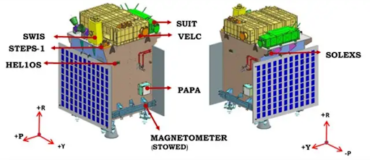
Payloads along with their major capability of scientific investigation
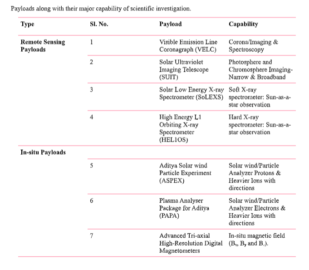
The route and destination of the Aditya-L1 satellite:
Aditya-L1’s route to LEO will be like Chandrayaan-3’s. Once the spacecraft reaches LEO, the onboard thrusters will maneuver it in a series of elliptical orbits that will move the spacecraft until it escapes Earth’s gravitational influence. (The onboard thrusters on the Aditya spacecraft are small rocket engines that use the onboard computer to control the spacecraft’s attitude and orbit till the end of the mission.) After this, the satellite will cruise on a coasting part towards the L1 Lagrange point. This method is used as it has the best propulsion efficiency and will conserve the most propellant. The estimated time to reach the L1 point will be 109 days after launch.
Once the Aditya-L1 reaches its destination, 1.5 million km from Earth – approximately 1/100 the distance between Earth and the Sun – it is placed into a halo orbit. (A halo orbit is a type of orbit that allows the satellite to remain in a stable position between the Earth and the Sun.) Here the satellite will use its onboard scientific instruments to document the dynamics of the solar atmosphere, magnetic field, solar flares, and solar wind without t occultation or eclipses interfering with its data collection.
What are Lagrange points?
There are five locations around a planet’s orbit where the gravitational forces of the Sun and it interact and create a stable zone. These five zones are a good “parking” spot for spacecraft as spacecraft at this position use the least amount of fuel to maintain their position. The points are known as Lagrangian or ‘L’ points, named after the 18th-century Italian astronomer and mathematician Joseph-Louis Lagrange (born Giuseppe Luigi Lagrangia), the discoverer.
- • Lagrangian point 1, L1, is found between the Sun and Earth. This position is good for monitoring the Sun as there is no occultation of the eclipse to interfere with the observation. Additionally, the constant stream of particles from the Sun, the solar wind, reaches the L1 point approximately an hour before reaching Earth. SOHO is a notable spacecraft that can be found in this position.
- • On the night side of Earth, we can find Lagrangian Point 2, L2, around 1.5 million km from the planet. (This is the same distance as L1 from Earth.) The L2 position is a great place to observe the larger Universe. A spacecraft at this position does not have to orbit Earth and thus does go into the Earth’s shadow. The recently launched James Webb Space Telescope is a notable spacecraft in this position.
- • We can find the Lagrangian Point 3, L3, on the far side of the Sun. Objects in the L3 point are not seen from Earth. Currently, we do not have any spacecraft at this position. However, if we manage to place a satellite in this position, we will be able to observe the far side of the Sun.
- • Lagrangian points 4 and 5, L4 and L5, can be found 60 degrees ahead and behind the Earth. We usually find dust and asteroids at these points. Stereo A operates at L4 while STEREO B used to operate at L5.
Objects at L1, L2, and L3 positions are in a meta-stable state. They need frequent maneuvering to stay in orbit around the points. Without any maneuvering, the spacecraft will start moving away from the position. Meanwhile, objects in the L4 and L5 are resistant to gravitational perturbations. They rarely need maneuvering to stay.
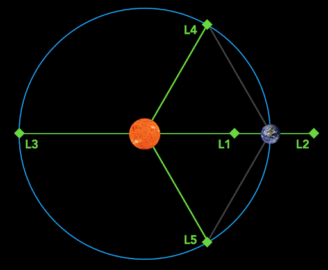
Space-India celebrated this momentous occasion with a variety of events and activities. Since ISRO’s announcement, our educators continuously raised awareness about the mission. Additionally, they have encouraged students from classes 8-12 to participate in the online quiz that ISRO organized in conjunction with the launch.
Aditya L1: Inching towards its destination
Aditya-L1 is a complex and challenging task. The success of ISRO’s flagship mission will showcase India’s abilities in space science while strengthening India’s ties with other sea-faring nations as it was a major international collaboration.
Even without the political implications, Aditya-L1 is a major scientific undertaking. The data gathered is expected to provide valuable insights and aid in increasing our understanding of our parent star and its impact on Earth.
Currently, ISRO predicts the mission’s lifetime to be four to five years.
—
Enroll in our School Programs or Online Programs, call us at : +91-95991 91909 or write to us for any query: getintouch@space-india.com
